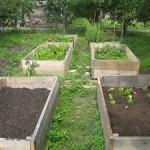
Raised garden beds are extremely popular these days, however, some beginning gardeners ask themselves why they need raised beds at all.
At first glance, they do not seem to offer much advantage over planting directly into the ground.
If one conducts a quick search on the internet to try to find out what the advantages of raised beds are, one will see responses like this:
- Raised garden beds, being raised, allow the gardener to avoid having to bend over too far to tend to the garden.
- They allow the gardener to control the soil that goes into them
- They raise the temperature of the soil
- Can cut down on weeds if one adds a weed barrier such as cardboard to the bottom.
To the beginning gardener who does not want to spend a lot of time and money on a garden, a lot of the above benefits do not really matter do they?
A beginning gardener can clear a space on the lawn in whatever shape and size they want, and plant a garden directly into the soil without having to buy lumber and construct boxes.
As far as soil goes, one can still amend the soil however they wish—what does the container offer?
One can clear a garden plot, put down a weed barrier, and then add 3 feet of new soil and compost on top of it if desired, right?
Disadvantages of Raised Beds
Raised garden beds seem to offer many disadvantages vs. garden plots placed directly on the ground.
They are expensive and can be difficult to construct for the average gardener not experienced with carpentry.
Additionally, buying specialized soil mixes at the big box store can be very expensive and labor intensive, especially if you want to have a large garden.
Raised garden beds have a very permanent feel to them and often do not look aesthetically pleasing. Many of us don’t want our garden to consist of a series of wooden rectangles.
Additionally, using treated lumber (chemicals) seems like a bad idea, and specialized soil mixes can contain many unwanted chemicals also.
There is one major factor that is overlooked by the beginning gardener, however: soil erosion.
And this is why you may need some form of raised garden beds.
One year, I constructed beautiful garden plots that curved around my property. I added lots of homemade natural compost and mulch and grew a terrific bounty of produce.
The next Spring, I returned to my garden paradise to find that it was…gone. My lush soil was not there. The beds had converted back to lawn! How is this possible?
The reason this happened was due to soil erosion and compaction.
The average backyard lawn-covered soil is compacted and flat, and rainwater is encouraged to flow across the yard and down to the street.
A few late fall and early spring rains can literally wash away your garden.
Raised garden beds prevent garden soil from washing away by physically blocking this running water. Therefore raising your garden beds is absolutely essential for many serious gardeners.
Over time, a raised bed that one continues to mulch with organic materials will become increasingly more fertile.
But the rectangle wooden box is not the only option.
In our opinion, the best form of a raised garden bed is a swale / Hugelkultur bed built on contour. See our article on Hugelkultur.
The Swale / Hugelkultur bed built on contour is aesthetically pleasing, “dirt” cheap, fully organic, and self-watering! Build a few of these strategically around your property and you will retain your rainwater, prevent runoff, and keep your soil.
But we still use raised beds. In fact, I’ve begun to incorporate Hugelkultur inside of the constructed raised beds by lining the bottom with rotted fire wood. And, I must confess that I like to have formal raised beds near the house because they are convenient and look pretty nice. I tend to construct the hugelkutur beds further away from the house.
If you are resourceful and handy, you can make raised beds out of old pallets that a lot of companies will be willing to give you for free. It takes a little bit of time to separate the boards and remove the nails, but once you have the bare pallet wood, the nice thing is that it is already good to go for outdoor use.
Additionally, there are lots of cool raised bed kits that can be purchased on Amazon, and some even come equipped with an optional hoop house feature. The one I’ve linked to above is cedar and will last a long time. The products link below also features some of my favorites.
Thanks for reading, and please share this article if you found it helpful.
